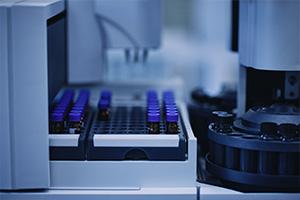Analysis
Scents are invisible and formless, but in order to create flavors and fragrances, it is important to know what components they are composed of.
In order to understand the composition of volatile components, we use a variety of instruments to analyze the components. We also check the chemical structure and quantity of non-volatile components.
We also perform measurements related to product quality.
Natural product

We analyze scents that exist as volatile components, such as the components of living flowers, flavor components in food, search for off-odor substances, and changes in scents over time.
If it is a new component that is not known, we determine its chemical structure.
At the same time, we are developing a technology (AROMASCOPE® method) to collect and analyze odorous molecules in their natural state, and are working to utilize this technology to create flavors and fragrances.
Development articles

The analytical data of natural products obtained by analytical chemistry is utilized for the synthesis of aroma ingredients and the development of specialties for creative use.
We also analyze confirmations during the development of aroma ingredients and fine chemicals.
The ratio of components that have been volatilized from fragrances and foods is also analyzed and utilized in the development process.
Products

We conduct physical and chemical tests, microbiological tests, and other analyses on product candidates in order to control product quality and formulate product specifications that contribute to quality assurance.
We also conduct ingredient verification analysis to confirm the certainty of raw materials used in manufacturing or to select raw materials.
Measurement and Analysis Techniques
Gas chromatography (GC) is mainly used for the analysis of volatile components. For non-volatile components such as catalysts and refrigerants, liquid chromatography (LC) is also used.
When necessary, measurements are performed using instruments that provide structural information. Information on optical activity, including odor analysis, is also required. The obtained data is analyzed to determine the component composition and structure.
Substance Analysis

The ability to determine chemical structures is necessary for the development of new aroma ingredients and support for other departments.
For chemical structure information, we use a variety of instruments such as high-resolution mass spectrometer, nuclear magnetic resonance spectrometer, and single crystal X-ray diffractometer.
In recent years, we have been working on the "crystal sponge method," an X-ray diffraction technique that does not require single-crystallization, and we use it to determine new compounds and optical activities in minute quantities.
Odor analysis

With GC as the core technology, we perform component analysis by introduction methods of various forms of samples and detection methods involving the human nose.
Many instruments, GC general detection, GC-olfactometry, GC/mass spectrometry (GC/MS), solid phase micro extraction (SPME)-GC/MS, headspace GC/MS, GCxGC/MS, chiral separation GC, etc., are used for analysis depending on the purpose.
Analysis for control

Our analytical technology department is ISO/IEC17025 certified. We carry out physical and chemical tests and microbiological tests related to quality control and quality assurance of products and raw materials, and ensure that customer requirements and quality assurance are met.
In order to ensure consistent quality on a global scale, we are working to unify and further improve our analytical and quality assurance technologies, with Japan playing a central role.